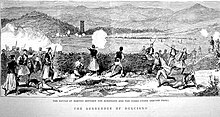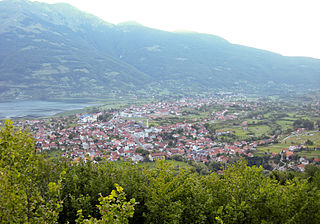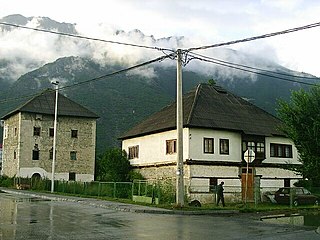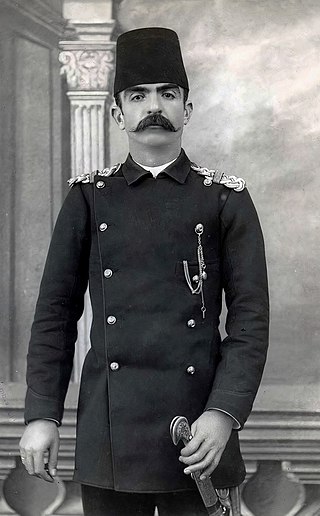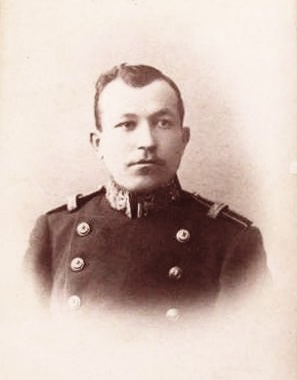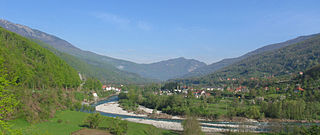Background
Montenegro accepted the propositions made at the meeting of the Great powers in Istanbul, in 1880 in order to exchange the regions of Hoti and Grude with Ulcinj. [2] Officially, the Porte did not resist the decision but explained that the Albanians would resist. The Ottomans had intention to delay cession of Ulcinj to Montenegro hoping to eventually avoid it, but Great powers were not ready to accept any delay and threatened to use force against the Ottomans. [3] The Ottomans supported Prizren League as long as their interest corresponded with the interests of the League. [4] According to some reports, the Ottomans actually armed Albanian irregulars with 3,000 rifles and 1,000 cases of ammunition in the coordinated actions of Shkoder vali Izet Pasha, commander of Ottoman forces in Tuzi Osman Pasha and Odo Beg Sokolović who was appointed as commander of the forces of Prizren League. [5] Ulcinj had been the main port of Shkodra in order to get access to the Adriatic sea. The Albanians vehemently protested towards this, calling it injustice. [6] The Great powers did however nothing to take into consideration the demands of the Albanians. The Ottomans, expecting trouble, sent their forces in Ulcinj to clear it from resistance. The Albanians, under the leaders of Isuf Sokoli, Haxhi Mehmet Beci and Mehmet Gjyli responded with an armed uprising. The Ottomans were unable to get to the Albanians as they had surrounded the city. The Great powers threatened with a naval demonstration if the Ottomans did not overrun the Albanians. [7]
The Ottomans, frightened by the Great powers, sent Riza Pasha with 3000 soldiers to Shkodra to crush the League of Prizren. Riza Pasha warned that anyone who stood in the way would suffer the consequences. Riza Pasha proceeded to declare a total isolation of the city of Shkodra, banning all merchandise in order to starve the Albanians of Ulcinj. 2000 Albanians, commanded by Muftar Aga Reci positioned themselves in Kraje, at the mountains of Mozhura, in order to make the transportation of Riza Pashas forces as difficult as possible. The Great powers, hearing that Riza Pasha had failed to siege Ulcinj, sent their naval armadas outside the bay of Ulcinj, consisting of English, French, German, Russian, Italian and Austro-Hungarian along the coast of Dalmatia. This, however did not frighten the Albanians. [8]
Pre-war and Resistance
The Battle of Ulcinj was a battle between the Ottoman forces of Dervish Pasha and Albanian guerilla fighters of the League of Prizren on November 22, 1880 for ultimate control of the city of Ulqin. Following the Russo-Turkish War and the subsequent Treaty of Berlin, the Principality of Montenegro agreed to territorial exchanges with the Ottoman Empire. Since the formation of the League of Prizren, there was a growing sense of nationhood during the “Rilindja” period in the 19th century where many Albanians sought to create a unified state – within the Ottoman Empire. After the Treaty of Berlin, many Albanian lands were partitioned to neighboring powers, which fueled the league to pursue any measure necessary to bring Albanian-speaking lands together. Regarding our story here, the exchange in question that led to the Battle of Ulqin was the transfer of the regions of Hoti and Gruda from Montenegro the Ottomans in exchange for Ulcinj. While the Porte officially did not oppose this decision, it asserted that the Albanians would offer a staunch resistance to this policy, as it would separate them from the Vilayet of Shkodra and isolate them in a land that was predominantly Slavic and orthodox Christian. The Ottomans initially sought to postpone the secession of Ulcinj to Montenegro, hoping to avoid it altogether. However, the Great Powers (consisting of Great Britain, France, Germany, Italy, and Austria-Hungary), unwilling to tolerate any delay, threatened the use of force against the Ottomans if they did not capitulate and agree to their end of the bargain. Fearful of the consequences imposed by the Great Powers, the Ottomans dispatched Riza Pasha with 3,000 soldiers to Shkodra to crush the League of Prizren. Issuing warnings of severe consequences for anyone opposing him, Riza Pasha implemented a total siege, completely isolating Shkodra and the surrounding lands to choke the Albanians of Ulqin into submission. Positioned in Kraje, at the mountains of Mozhura, 2,000 Albanians, commanded by Muftar Aga Reci, aimed to hinder the transportation, and disrupt the supply lines and wagon trains of Riza Pasha's forces and temporarily lifted the siege. In response, the Great Powers granted Riza Pasha a three-day ultimatum to surrender the city to Montenegro. Despite the presence of 6,000 Ottoman soldiers in the city, their attempts to advance were effectively impeded. The Great Powers, upon learning that Riza Pasha had failed to besiege Ulqin, deployed a naval armada lead by Lord Admiral Frederick Beauchamp Seymour: 1st Baron of Allsterr and consisting of English, French, German, Russian, Italian, and Austro-Hungarian forces along the coast of Dalmatia and Montenegro to ensure the successful transfer of Ulqin to Montenegro. Surprisingly, this united and formidable display of naval power did not intimidate the Albanians, and they continued with their resistance. In response to the challenges encountered, Riza Pasha was relieved of his duties – and the Ottomans appointed Dervish Pasha, the former WALI of the Vilayet of Salonika, as the new WALI of Shkodra and tasked him to bring the Albanians to heel and deliver the city to Montenegro. On November 1, 1880, Dervish Pasha, accompanied by 1,300 Ottoman infantry arriving by ship, attempted take Ulqin by sea - however, he received staunch resistance posed by Albanian guerilla fighters stationed at Ulqin’s citadel, and was forced to take different measures.
Upon his arrival, Dervish Pasha issued an ultimatum to the irregulars refusing to surrender Ulcinj. 800 Ulqinaks, along with volunteers from Tuzi, Shkodra, Tetovo, Shkreli, Dibra, Kelmendi, Prizren, and Gjakova, the ultimatum yielded no results. British and Hungarian consultants in Shkodër negotiated an agreement with Dervish Pasha, that will allow him to persuade the Albanians to surrender the city, proposing safe passage to leave the city and settle within the empire. After three days of unsuccessful bargaining, Dervish Pasha ordered his army to march into the city. On November 22, 1880, Ottoman forces under the command of Dervish Pasha crossed the Bojana River near the village of Kllezna. They encountered a small unit of Albanian irregulars encamped near the Lake of Shas, initiating a skirmish where both sides exchanged gunfire. During the night, Albanian irregulars received reinforcements of 500 men and continued the battle until they were forced to retreat. The decisive clash between the Albanians and Ottomans occurred at Kodra e Kuqe, outside the city of Ulqin. Led by Isuf Sokoli, Haxhi Mehmet Beci, and Mehmet Gjyli – the Albanians prevailed against the first wave of Ottoman forces, however, with the arrival of additional Turkish reinforcements eventually led to their retreat and inevitable defeat. Commander of Ulcinj’s militia - Isuf Sokoli, was wounded and later succumbed to his injuries on the same day, along with many other Albanians who courageously sacrificed themselves against a world superpower. On November 23, 1880, the Ottomans continued their march into the city, ultimately surrendering it to the Montenegrin army. The official handover marked the culmination of a 30-month-long negotiation process involving European powers, concluding the battle. Despite Dervish Pasha's attempts to encourage the population of Ulcinj to emigrate to the Ottoman Empire, no one departed before the arrival of the Montenegrin army, given their prior experience as Montenegrin citizens from January 1878 to February 1879. The local population, in a strange brew of elation, confusion and anger – took to the streets to witness Montenegrin Army receive the command of the city. On the “day of liberation” - Montenegrin Voivode - Božo Petrović received a welcome from city leaders and assured them that there will be peace. Petrovic demanded the organization of elections for the City Assembly and court, with Voivode Simo Popovic being selected as its first Mayor – thus beginning Ulqin’s new reality of being subjects to the Montenegrin crown.
